|
THE TRADITIONAL PERSIAN
(DOLL FACE) HISTORY ©
Traditional Persian Breeders
Diana Fineran March 14, 2002©
The origins of the Traditional Persian (Doll Face) are
shadowed by long years of history. Let it be said that this gloriously long
haired breed has been enjoying existence among us for many decades.
 |
Click on Picture To Enlarge |

|
By the time cat shows began in England it was already a well
established, admired breed. The Angora was the "other" long haired
breed of the time, which was said to have a rather smaller head, with larger
ears and fur more silky with a tendency to wooliness, in comparison to the
Traditional Persian (Doll Face). Breeders trying to increase their Traditional
Persian (Doll Face) breeding stock began using the Angora, causing the Angora to
gradually disappear from British soil.
|

|
Click on Picture To Enlarge |

|
An interesting comparison to short haired cats gives the
comments that the Traditional Persian (Doll Face) are not so amiable, or so
reliable in their temperament. However, they are more intelligent and have a
greater instinctive desire to make themselves at home in their surroundings.
"The longer the coat the weaker the cat." One breeder stated. Kittens
with unusually long fur were more difficult to raise and suffered from extreme
delicacy. Inbreeding was blaimed for this. They require a great deal more care
than short haired cats, because of the required grooming to keep their coat in
order. Shedding causes these cats to have a rather lesser coat in the summer
months. It is in the winter months that the Traditional Persian (Doll Face) is
in its prime coat. In the early years there were two classifications of
varieties of cat breeds. One was called the long hair or Eastern cat and the
second was the shorthair or European cat. By 1902 the entries at large British
cat shows were four to one with the Traditional Persian (Doll Face)
predominating.
|

|
Click on Picture To Enlarge |

|
COLORS
BLACK: Originally this color was to be absolutely uniform
through out. No brown, rusty tinge, white hairs., shading of gray or blue and no
undercoat of a lighter shade were allowed. Only full, round, deep orange eyes
were acceptable. They were known to be very strong and healthy, often growing
into large, massive cats. Breeding a true black could be come from a
tortoiseshell female with a black male or two brown tabbies. Neither numbers of
black nor prices paid for them were high in the beginning. Still they were used
to intensify the coloring of silver tabbies and smokes.
|
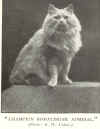
|
Click on Picture To Enlarge |

|
In an early article from "Our Cats Magazine" an
un-named author wrote, "White cats with blue eyes are not often to be
obtained from abroad, neither are the black warranted to possess the amber eyes
voted correct by up to date cattists. I know of a black queen straight from the
land of cats and the palace of the Shah himself. It had the most glorious
emerald eyes it is possible to imagine. As different from the ordinary run of
green as flaming amber is from faded yellow. This cat, a Persian among Persians,
had a coat as black as the proverbial jet, perfectly black throughout, long and
straight, of fine, silky texture, but not giving one the impression of
massiveness that is such a prominent feature of the type of imported cat.
Moderate in size, slightly built, with an expression so foreign that it amounted
to weirdness. This cat could with a dash of imagination have been worked up into
the incarnation of a spirit, a soothsayer, the veiled beauty of a harem, a
witch, snake charmer, what you choose, but always remain something far apart
form prosaic England, something tinged with romance and the picturesqueness of
the mystical East. This black cat was undoubtedly a typical Persian."
|
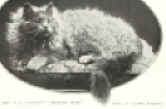
|
Click on Picture To Enlarge |

|
Old catalogs of Crystal palace shows proved that the number of
Black entries were scarce. In 1886 the black male class was marked, "No
entry." In 1889 Mrs. H. Warner (later Hon, Mrs. McLaren Morrison) made the
sole entry of "Imp" in the black class. In 1890 Mrs. Warner exhibited
"Satan", a black who was never beaten in all his years of exhibition.
He was described as, "The most remarkable of unapproachable excellence. A
veritable triton among minnows." Show Secretaries commonly put sentences in
their reviews such as, "Good black with orange eyes were conspicuous by
their absence", or "The black classes, as usual, were poorly
filled."
|

|
Click on Picture To Enlarge |
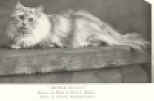
|
WHITE: By 1902 some interesting details were presented,
especially about eye color. A great change from yellow eyed whites to blue eye
color, formerly considered quite rare, came about. The most perfect white
Traditional Persian (Doll Face) at that time was found among the imported cats
due to their certain beauty of form and silkiness of fur, unusually long coats,
round heads, tiny ears and wonderful toe tufts, which were not possessed by the
specimens bred in England. A draw back was mentioned about the rather savage
disposition of the imported cats. Although they would be sweet tempered enough
with human being, they were extremely fiery with their fellows.
|

|
Click on Picture To Enlarge |

|
Two points to consider about white Traditional Persian (Doll
Face) in the early days was that they were frequently stone deaf, and they very
often had odd colored eyes. The two colors being blue and yellow. Once in a
while one would have sea-green eyes. Still the usual color was heavenly blue,
not so much of a sapphire, but more of the deep forget-me-not blue.
Americans created a demand for white Traditional Persians
(Doll Face) with blue eyes, which exceeded the supply of imported cats. In an
early Beresford Cat Club Show (Chicago) the entries in the white classes were
very large. Golden and blue eyed whites were subdivided according to sex, with
all classes well filled. Mrs. Clinton Locke’s, "Lord Gwynne" was a
noted white stud cat in the U.S., as was Mrs. Colbourn’s "Paris".
|

|
Click on Picture To Enlarge |

|
OLD BIRTISH CATTERIES
MISS WHITE ATKINS: Bred white Traditional Persian (Doll Face).
BISHOPSGATE CATTERY: Owned by Lady Marcus Beresford, this
cattery had both Traditional Siamese and Traditional Persian (Doll Face). Among
her "Persians" were "Blue Boy II" and "Beetle".
One of the most lovely white imported cats was exhibited by Lady marcus
Beresford at the Westminster Cat Club Show in 1900. The best judges declared
that there was not a fault to find with "Nourmahal", but her career
was a short one.
|

|
Click on Picture To Enlarge |

|
BOSSINGTON CATTERY: This cattery was owned by Mrs. Collingwood,
of Leighton Buzzard, England. She maintained the numbers of cats in her cattery
to about 30, divided equally between short haired and long haired varieties.
Blues were her greatest favorite, which caused her to be on the Blue Persian Cat
Society Committee.
|

|
Click on Picture To Enlarge |

|
"Royal Bobs", a big, massive blue male, did a lot of
winning for her. He was bred by the Princess Victoria of Schleswig-Holstein. His
sister, "Jill" lived in one of the 12 cat houses distributed over the
five acres grounds of Bossington. Small houses were mostly on wheels. Larger
houses were kept for females and their kittens. Sometimes a corner of the hay
loft was set aside for a mother cat too. Males cats were let out in the mornings
and joined in the afternoons by the females. Mrs. Collingwood didn’t keep a
stud cat, but neutered pets had their run about her house and ate their meals in
a corner of the dining room.
|
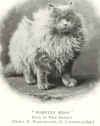
|
Click on Picture To Enlarge |

|
Her ambition was to breed for smokes, to breed a perfect
silver tabby and a perfect orange tabby.
"James’ was her beautiful silver tabby and during 1902
he won eight first prizes. At Altrincham he had the honor of claiming
championship and the silver medal for the best cat in the show, beating all the
long haired cats that generally carry off that coveted prize. At the Crystal
Palace he was the admired of all admirers, with a number of prize tickets
covering his pen.
There was great devotion shown to cats at Bossington. Mrs.
Collingwood supported cat shows by making several entries, by guaranteeing
classes and by giving handsome prizes. Her cats were always shown in the pink of
condition with her in attendance.
|

|
Click on Picture To Enlarge |

|
MRS. S.F. CLARKE: Not every breeder had the luxury of having a
lot of space in the country to breed cats. At her small house at Louth, England,
Mrs. Clarke has great success breeding Blue Traditional Persians (Doll Face).
MRS. LENTY COLLINS: Her famous black Traditional Persian (Doll
Face) was the wonderful big eyed, "Forest Beauty".
MRS. CROWTHER: In the North of England this cattery
specialized in Black Traditional Persians (Doll Face).
KEPWICK CATTERY: Mrs. Warner first exhibited her black cat
called "Imp" at the Crystal Palace Show in 1889. Since black cats were
said to bring good luck, he took a first place. Thus encouraged, Mrs. Warner
began her cattery. Later Mrs. Warner became Hon. Mrs. McLaren Morrison, who
entered 14 cats in one show. Among them were two imported cats and the famous
black Traditional Persian (Doll Face), "Satan". In 1897 Satan, with
his glorious orange eyes, won everything he could at the Crystal Palace at an
advanced age. He passed away in 1902, leaving a worthy son, "Lucifer"
to take his place at Kepwick Cattery.
|

|
Click on Picture To Enlarge |

|
In 1890 Mrs. McLaren Morrison, then Mrs. H. Warner, made a
name for herself as an exhibitor of white Traditional Persians (Doll Face). Six
silvers won prizes at Sydenham that year.
Mrs. McLaren Morrison writes, "I have always been lucky
with black cats, both long and short haired, but I especially love white
Traditional Persians (Doll Face), and, in fact, at one time I owned a
"white cattery". I may say I still have some good specimens, namely,
"Musafer" ( famous imported cat), "Queen of the Pearsl" and
"Lily". I love the imported cats, and always get them when I can. I
have nine now at Kepwick. One of these hails from Patagonia and one from
Afghanistan. My cattery at one time was twice again as full as now, but my
losses have been great, and I have reduced the numbers so that I may give more
attention to the young stock."
"It is only recently I have really gone in for orange
Traditional Persians 9Doll Face), encouraged by the wins of "Puck" at
the Botanical. I love this beautiful variety, but consider the queens of this
breed very delicate. I have owned some fine blues at different times, and
purchased for 25 pounds a beautiful fellow, bred from ‘Beauty Boy" at the
Crystal Palace many years ago, but alas! He came home only to die. Foremost
amongst my blues ranked my late Champion "Monarch", who held the
Beresford Cup. Of late years I have taken up silvers. My first Chinchillas was
Champion "Nizam", ancestor of such cats as "St. Anthony" and
"Ameer". I bought "Nizam" at the Crystal Palace in the early
days of silvers, and he only took second prize, because, I was assured , he was
"too light" for first. I have a few Russians. I am most devoted to my
pussies, and have tried to persevere in breeding good stock in the face of very
great difficulties. I do not much care about running the risk of showing, but a
true fancier likes to support all well arranged cat shows."
LADY DECIES’ CATTERY: This cattery was at her pretty summer
residence at Birchington-on-Sea, where perfect arrangements were made in every
detail for the comfort and well being of the resident cats. The stud cats had
separate single houses, with good sized wired in runs and luxurious and cozy
sleeping apartments in the rear.
The main cattery was in a sheltered portion of the grounds,
and accommodated a large number of cats. The runs were arranged with boxes,
bunches, chairs, and ladders and the sleeping quarters were built of brick and
made very comfortable. A system of wooden blinds to the sides and on top kept
the strong sea breezes and the bright rays of the summer sun regulated. Wood
floors covered with cork carpet and raised about a foot from the ground kept a
free current of air passing under the boards, keeping any dampness away.
Three rooms of Lady Decies house were dedicated to her cats.
In two rooms the mother cats had their families, and the other was used as a
"cats’ kitchen". Lady Decies herself designed and made the
comfortable cat beds herself. The walls were adorned with pictures by Louis Wain
and a display of prize cards won by her famous cats.
Zaida, a well know winning Silver female, lived in these
quarters on soft cushions and couches. The famous and noted winner ,"Lord
Southampton", was in her possession, after being purchased for a very high
price. As a silver sire, he attained great success, having sired numerous
winning kittens. His name in a pedigree was a safe guarantee for quality and
color. Her cat, "Powder Puff" was presented to H.H. Princess Victoria
of Schleswig-Holstein.
A woman and a boy were hired to attend to the care of her
aristocratic cats.
MISS KERSWILL: A successful and enthusiastic breeder of white
Traditional Persian (Doll Face).
LESTOCK HOUSE: Begun in 1882 by Mrs. Herring in Lee England,
this was a prominent cattery. Mrs. Herring was an enthusiastic member of the
National Cat Club Committee, several of the specialist clubs, the Cat Club and
the Northern Counties Cat Club. Her exhibits were well known for their quantity
and quality with several wins to their credit. She would undertake to enter
between 25 to 30 cats per show, arriving with her in a large omnibus or van.
Starting with a short haired silver tabby called "Chin", she quickly
turned her attention to long haired brown tabbies, where she chiefly made her
name.
"Jimmy" was her superb specimen of a well marked
silver tabby and he won everything he entered. He passed away in 1900, and it
was said that they would not see the likes of him again.
Among many cats at Lestock House, "King Saul" was a
noted tortoiseshell tom who won the Coronation Cup at the Botanical Show.
"King Alfred", a Traditional Persian (Doll Face) silver tabby and
"King Alfred" were well known winners in their day.
Two sensational silver tabby Traditional Persian (Doll Face)
kittens she bred were ‘The Duchess" and "Princess Lestock".
They were exhibited respectively at the Westminster and Crystal Palace shows
where both were quickly claimed at the high catalog price. "Floriana"
a huge, handsome Traditional Persian (Doll Face) brown tabby went to a new home
in America.
Complaints of neighbors forced the reduction of over 40 cats,
because several cat houses had to be removed due to their encroachment on the
neighbors garden wall.
MISS HUNT: Bred white Traditional Persian (Doll Face) in
Scotland.
MRS. NOTT: Bred white Traditional Persian (Doll Face).
MR. ROBERT LITTLE; Bred Black Traditional Persians (Doll
Face). Some comments, "Few of these cats retain their proper color
throughout the year. The sun and exposure induce rustiness, and in some
instances to such an extent that the handsome jet exhibit of October or January
is hardly recognizable as the cat in July or August.
The kittens seldom become really black until some months old,
"Lady Bruin", for example, was so named on account of her brown or
rusty appearance. Her coat is now, and has long been, of the densest black.
Long-haired black cats as a class are not so heavily or
lengthily coated as some others. In many the coat resembles hair rather than
fur, and these I have found the more consistently black and less liable to
variation in shade. The tendency in all, however, is for the coat to become
blacker with age.
The eyes of the kittens for the first month are blue. They
then gradually change, and by the end of the second month it may be fairly
ascertained whether or not they will possess the much coveted orange hue.
Several moths, though, elapse before the shade is permanently determined, but I
have never experienced a lighter shade supervening on a darker.
It is not necessary for both parents, or even either, to
possess deep orange eyes in order to secure such in the kittens. I take it,
never the less, the desired tint must have been "in the family".
The variation in permanent depth of shading in the eyes of
members of the same litter is remarkable, and not infrequently the "white
spot kit" or other wise less valuable member has the compensating
qualification of deepest orange eyes.
The mystery of the white spot on the chest or throat has yet
to be solved. In most black litters one at least has this blemish, and this
generally settles the question which, if any, shall join the majority at a
tender age. The unfortunate kit’s pedigree may be absolutely devoid of offence
on this point. Apparently no precautions can prevent or eradicate the fault.
One of the most recent specialist societies to be formed is
the Black and White Club, having for its object to promote the breeding and
exhibiting of black and white cats, both long and short haired. In this last
detail it differs from the other specialist societies that confine themselves to
the one breed, either long or short haired ."
MRS PETTIT: Bred a tribe of blue-eyed whites in northern
England. A visitor counted more than a dozen long coated, full grown, bonnie
blue eyed beauties, walking around in the woods surrounding Mrs. Pettit’s home
near St. Leonards – On – Sea.
DR. ROPER: Bred Black Traditional Persians (Doll Face) from
the "Fawe" strain. He wrote these insights, "For many years black
Traditional Persian (Doll Face) were a most popular breed, but, like fashions,
for the time being other colors, I regret to see, are obtaining more notice from
fanciers. For years I plodded away to breed what I considered a perfect black
Traditional Persian (Doll Face). At last my labors were crowned with success.
What can equal a richly colored, heavily coated, deep orange-eyed black?
"In breeding black, like any other color, it is essential
you should procure the best of stock, and be prepared to give a fair sum for
such, otherwise you are almost sure to be disappointed in your results, and,
maybe, retire as a fancier of this color and try some other, but you will meet
with the same fate if you hold the same views as to expense. A black Traditional
Persian (Doll Face) should be perfect in color, with absence of white hairs,
cobby in shape, short in leg, tail bushy and not too long, eyes large and deep
orange, a good broad head, ears short with tufts and well set apart, short face,
coat long and silky.
Having stated the points, I will now give my experience of
breeding.
In my opinion, it is most important the sire should be a
black, and one of his parents a black, whatever color the queen is. I have had
great success in breeding from a black sire and a tortoiseshell queen. Through
this cross you may get either black or tortoiseshells. As an instance I quote,
"Johnnie Fawe" (black) and Champion "Dainty Diana"
(tortoiseshell). From these I have bred many good black, amongt them "Dick
Fawe", "Lady Victoria" and other good ones. Also good
tortoiseshells, three of them having taken championships. Black may also be bred
from a black and a blue, or two blacks. In this case, cross the sire with one of
this progeny, which I have found very successful (here is evidence of use of
inbreeding!). I admit there are other ways of breeding blacks, but in my
experience the three ways I have suggested have proved to be the most
satisfactory.
In breeding, to be sure of success so far as the eyes are
concerned, if possible it is better that both parents should have orange eyes,
the deeper the better, but it is most essential the sire should have good orange
eyes. Not with standing the queen’s eyes being light amber, by crossing with a
good orange-eyed sire the kittens are very likely to have good colored eyes, but
not vice versa. As an instance, I once purchased a very handsome black queen,
perfect in all point with the exception of the eyes, which were very light
amber. I mated her to "Dick Fawe", who had the deepest orange eyes I
have yet seen in a black. The kittens developed orange eyes. I have mated in the
opposite way, and the result has been unsatisfactory so far as the eyes have
been concerned, and if breeding for show the color of the eyes is most
important. The late Mr. Welburn, a well-known judge, once said in one of his
reviews of black at a large show (I think it was the Crystal Palace), "I
scarcely think that that eyes alone should carry an award, yet it is always best
to uphold the desired properties so hard to obtain."
"Having bred a litter of black kittens, it is unwise to
make up your mind what color they are going to be until they have attained the
age of six months. I remember once giving away a kitten at three months old,
which I called iron gray and thought would or could never be black. Six months
after I saw my friend, who thanked me very much for the lovely black kitten. Two
months after seeing him I saw the cat. There were no white hairs, and the color
was a perfect black. This last Richmond show I showed a black kitten, aged seven
moths. It took a first, a second, and a special. At three months old I thought
it was going to be a smoke. It was claimed by the Hon. Mrs. McLaren Morrison. I
have a kitten now, aged three months, perfectly bronze in color and a gray
frill. I have no doubt at seven months old it will be a perfect black. I have
given these illustrations in order that those who are thinking of going in for
black should not give up all hope of the kittens becoming black until the age I
have stated.
I breed my kittens from January to July, and find they do much
better in the catteries, all of mine being separate. And I find Spratt’s
moveable runs most useful In showing black they should be brushed and rubbed
with a Selvyt cloth daily one month previously and kept free of matted hair. The
application of Brilliantine or American Bay Rum in small quantity brushed on
gives a perfect gloss to their coats."
SEAGATE HOUSE: One of the largest catteries in Scotland, was
owned by Mrs. Mackenzie Stewart in Irvine. Her blue stud cat, "Ronald"
made a name for himself in England. Other colors in her ownership were silvers,
creams, brown tabbies and the celebrated black stud cat ‘Dick Fawe", who
sired many winning kittens. Mrs. Mackenzie Stewart traveled to London to show
and to judge at the large shows there.
MRS. WESTLAKE: Bred white Traditional Persian (Doll Face).
MRS. FINNIE YOUNG: Bred white Traditional Persian (Doll Face)
in Scotland.
Top of Page
Last Updated:
07/20/24
|

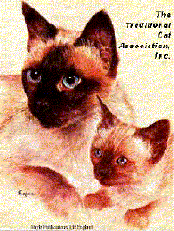 The
Traditional Cat Association,
Inc.©1987®TM
Official Website
The
Traditional Cat Association,
Inc.©1987®TM
Official Website

























